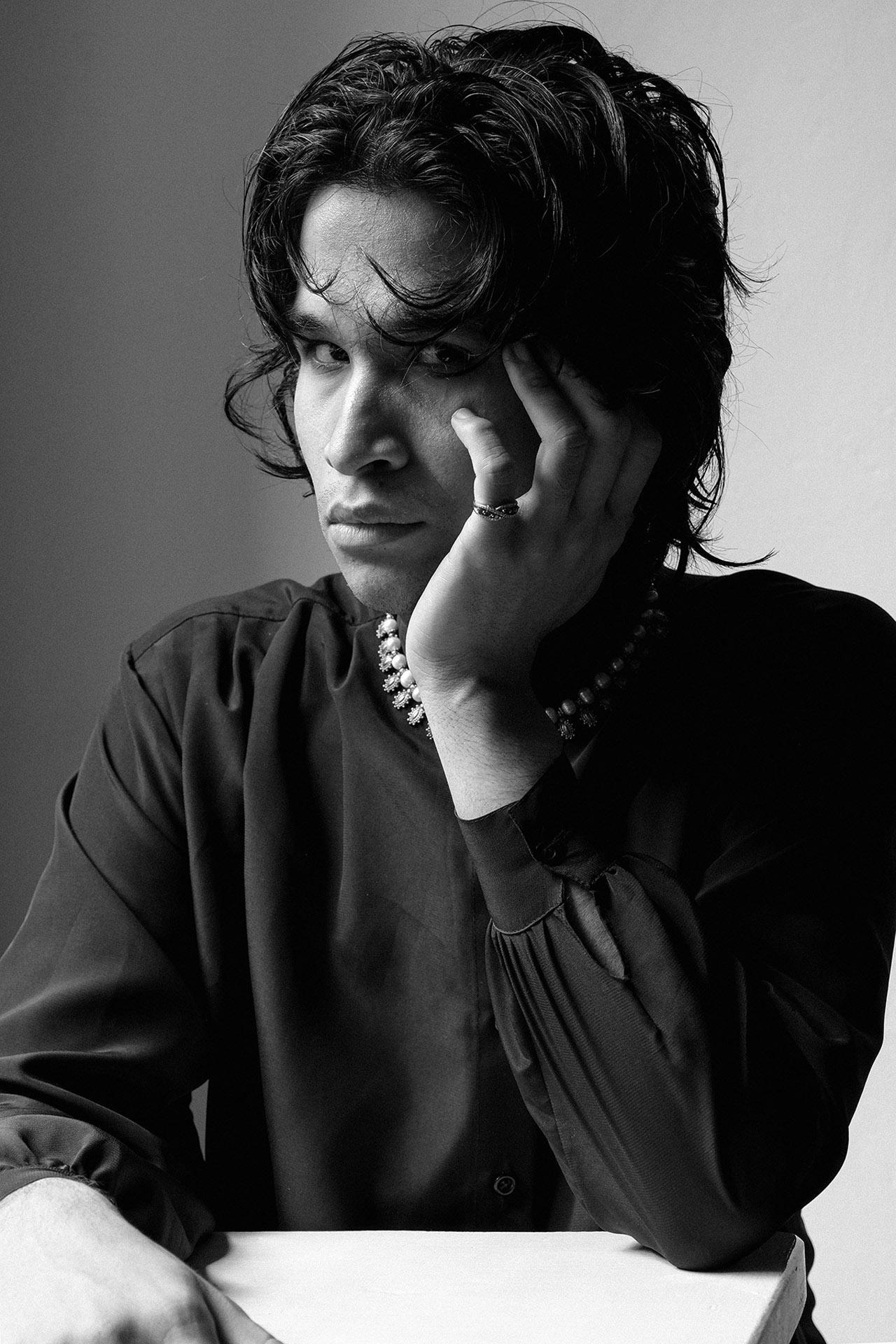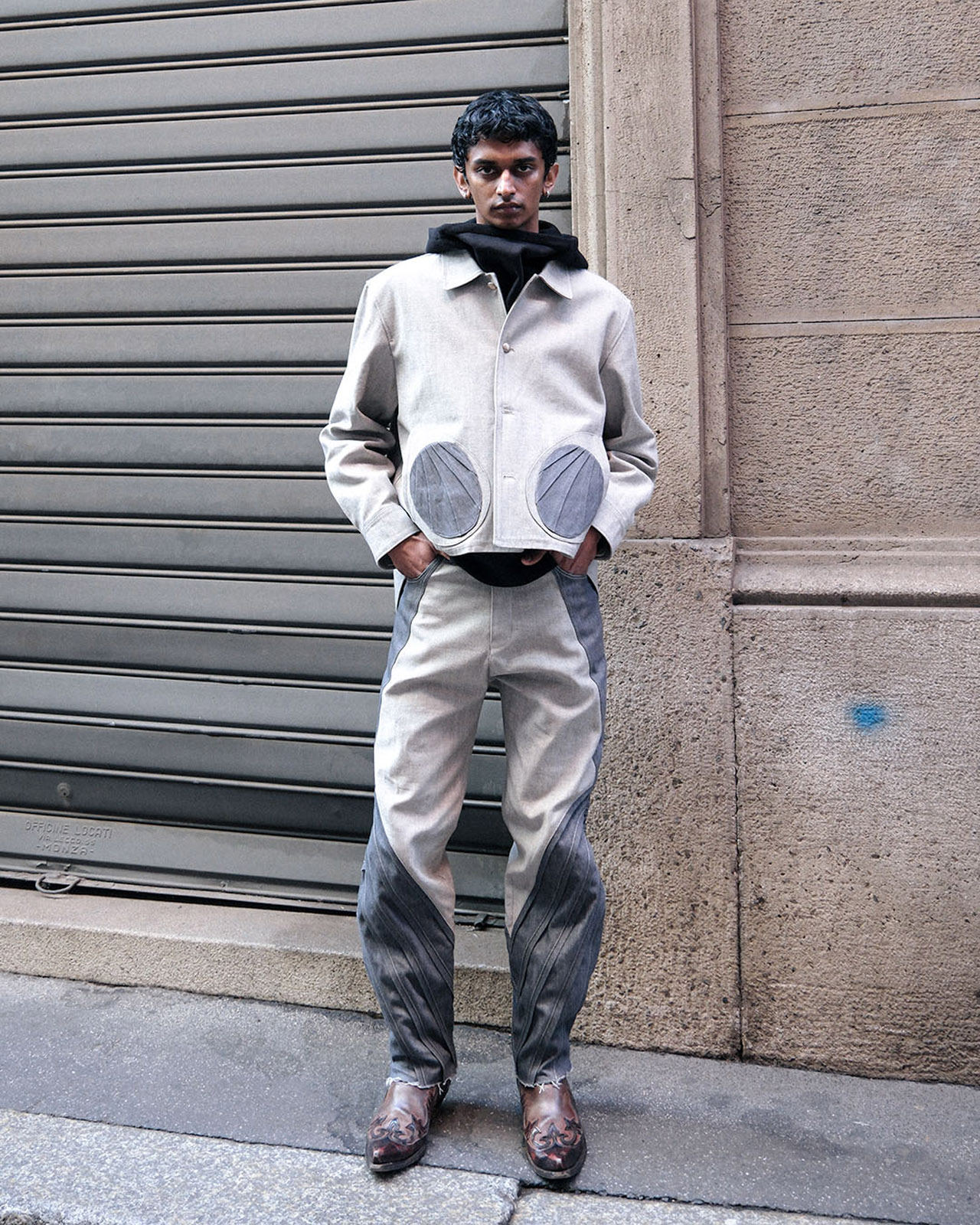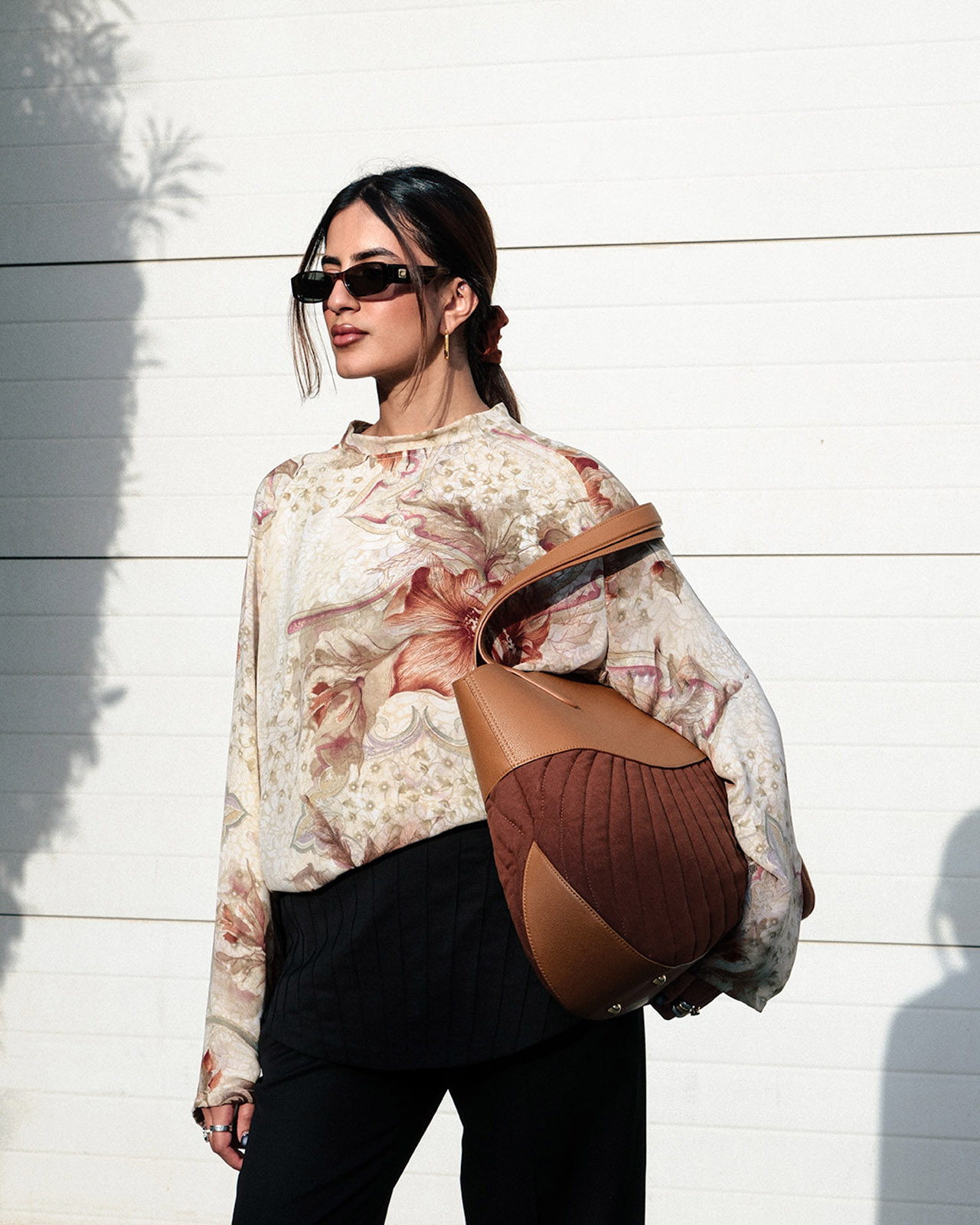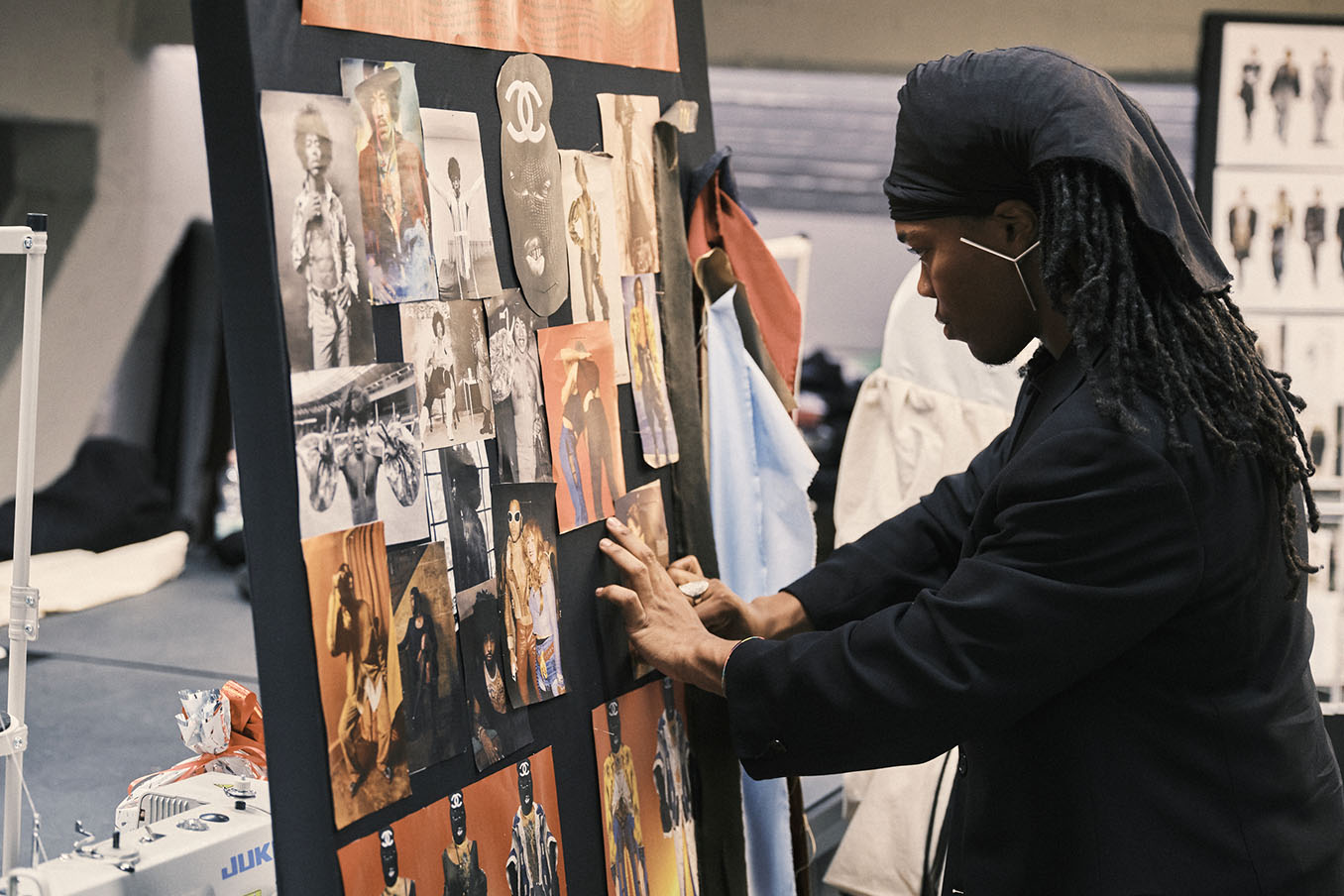Shivin Singh is a naturally curious and artistic designer, who is unconventionally relaxed when faced with fashion’s conventions around gender or representation. He is porous to the world, its beauty and art, and he radiates a sure optimism, something of a rarity nowadays. His ability to merge his personal cultural references with modern silhouettes and intentions makes for a contemporary and exciting debut collection.
Born in New Delhi and raised in Dubai, Shivin started off studying finance and accounting in the US before deciding to turn his attention to his lifelong interest, fashion. After completing the Undergraduate in Fashion Design Management program at Polimoda, he interned at Gucci in the Handbags Collection Merchandising team, before becoming Founder and Director at Absent Findings.

Here, he tells editor of the journal, Phoebe Owston, about what it’s really like establishing a brand today, his plethora of inspiration ranging from Indian modern art to Miles Davis, and his experience this March participating in the Afro Fashion Association’s Communities at Work initiative, which strives to build sustainable partnerships to ensure equitable representation and lasting change within the fashion industry.
Phoebe Owston: What got you interested in fashion and what course did you do at Polimoda?
Shivin Singh: Ever since I was a young kid, I was infatuated by clothes and not in a materialistic way, but in the way that clothes made me feel. I remember an early memory of being obsessed with Lacoste polos; I grew up playing tennis, so I was always part of this world, this preppy style. I loved the way that they made me feel. They made me feel adult, they made me feel like I was responsible. I think my earliest entry into fashion was through those polos. I was never a kid who grew up reading Vogue magazines or anything, it was about how certain clothes made me feel. I started to realize this when I was in the US. It was all within me, of course, but I was not able to express it in the right way when I was in Dubai because Dubai is like a bubble. You don’t really get to experiment, you don’t really get to truly understand who you are as a person. After that Lacoste phase, it was the Ed Hardy phase. Then of course, it graduated to the point of getting really into the Antwerp designers and getting into how Raf Simons runway shows made me feel, how I wanted to be one of those guys entering a room with that air about him, with that attitude.
I started at Polimoda with Undergraduate in Fashion Design in 2018. Then in the second year, I switched to the Undergraduate in Fashion Design Management course mostly because I was curious to learn about the process of working with leather goods, specifically handbags. My first entry into the world of fashion was through examining my mother’s fine handbags and seeing what kind of craft goes into producing something of such great value.
I really wanted to learn the craft of creating handbags and creating shoes. This was only possible in Fashion Design Management because I didn’t want to just study accessories design, I wanted to still focus on ready to wear as well. I made some really important connections as well with the class that I was in. All the professors were extremely supportive. It was a great time.
What is the ethos of Absent Findings?
From the get-go, I knew that I didn’t want the brand to have my name on it because I value my privacy and I don’t want to attach my name to something that is a creative outlet of how I’m feeling at a certain moment.
Absent Findings is a strange combination of words because you don’t really associate one coming after the other. At its core, Absent Findings is all about celebrating the beauty in what’s often overlooked. It plays with the idea of presence versus absence, using those contrasts to create pieces that feel personal and expressive.
I selected the words Absent Findings to represent the brand’s name because it represents those moments where you’re expected to be somewhere doing something specific but then you choose to be elsewhere, immersed in experiences that are unique to your inner self and that you resonate with. You’re absent from what society is telling you to do, what is laid out for you. Not because you’re lazy or because you don’t have the motivation to go through the motions. It’s about finding something that truly resonates with your soul.
This is something that a lot of my friends have felt. They’ve all had this moment in their lives where they felt like they were just going through the motions and then decided to change their trajectory completely, which I think every creative has to go through. That’s where you become more solid in your grounding. That’s what Absent Findings stands for.
What inspires your collections?
I’ve grown up with a lot of art around me. My mother is a stage performer. She does theatre in Dubai. I’ve always been extremely involved, watching a lot of Bollywood movies and then moving on to David Lynch films. The first collection is called My Personal References because I wanted it to really establish what the brand stands for. We’re trying to promote this different beauty that you don’t see in the Western world. We’re trying to showcase that my heritage is not just a way of making money for bigger brands. It’s about a real narrative. It’s about a story that needs to be heard.
My mom is Bengali and my dad is Punjabi. Growing up, I witnessed my mom wearing these beautiful saris. A sari is really, in my opinion, the most pure and elegant form of dressing because it’s a massive piece of fabric that has a lot of intricate work that goes into creating that fabric. The entire silhouette comes out of the drape of the fabric. I reinterpreted the draping of the fabric where the sari starts off extremely calculated, oftentimes pinned up as well with safety pins. Then as it goes down the torso and towards the legs, it becomes more fluid, it becomes more dynamic. This is something that I incorporated into my pieces for the first collection. The hoodies have this cowl neck effect which showcases and highlights the movement that a sari has in the bottom of its silhouette. Then you see the more structured contrast denim where the piping details are extremely calculated. They’ve been sewn together so that they don’t move so much, which you see on the top of the saris.
The color palette comes from the paintings of Vasudeo Gaitonde, an important artist from Bombay. The way that the paintings made me feel when I saw them for the first time evoked this sense of being at home; the color palettes that he uses are not very contrasted. They all feel muted. They all feel like there’s a layer of dust on top of them. These are the colors that I grew up seeing in Dubai.
There’s also a certain element of jazz that you can see in the combination of the pieces, especially in the look book pictures, where it seems like there’s a level of improvisation as well. That harkens back to the fact that I was listening to Bitches Brew by Miles Davis when I was designing that collection.
I’m not just listening to the music itself, but I’m trying to figure out who Miles Davis is trying to reference with this one little lick that he’s playing, or, what is David Lynch looking at when he makes this movie? The silhouettes that you see as well, they’re coming from the buildings that were designed by Le Corbusier in Chandigarh.
I see that color is very important to you, how do you approach and work with color?
To talk about color, I have to recall the pattern making side of things as well because I’m not pushing the silhouette to extremes. I’m not going crazy with how sculptural I can make certain pieces. I want these pieces to be worn and to be loved and to become a part of a uniform for certain people. How do I convey the emotionality of the collection? Oftentimes the color plays a massive role for that.
The color palette for the first collection, as I touched on previously, came from a painting by Vasudeo Gaitonde. I saw this painting in New Delhi in 2023 when I went to the Bharat Textile Fair, and it was in the Contemporary Art Museum. It was the first time that I was exposed to this painting. It was a very intense emotion that I felt standing in front of it. I stood there for 10 minutes, analyzing why it made me feel that way. The colors made sense to me beyond the emotionality of it as well. I then went back home and I did some research about the painter and looked at the painting more, printed it out and put it up on my wall.
I realised that it made me feel such a strong way because it contained the colors that I literally grew up seeing in Dubai. Dubai being an extremely hot place, the colors are not heavily contrasted as they are in Florence. They’re not vivid. They all seem to have a certain sheen of dust on top of them. It’s a beautiful thing because it puts your eyes at rest because your eyes are not being bombarded by contrasting colors. This layer of dust makes it feel dreamlike in a way.
That is the exact emotion that I wanted to portray with the first collection because it heavily goes into surrealism as well. Like the name of the brand, it comes from that emotion that I told you about. The way that I got to that emotion was by listening to an interview with Max Ernst. He said in this interview that every artist goes through a period where he’s within himself, going through things. The gears are grinding. It might be emotional turmoil, it might be something else. It might be a quiet space in his career. Then when he emerges from that, the vessel has been filled. Now he’s ready to come onto the canvas to create something of real beauty. That was exactly what I wanted to portray with Absent Findings.
To access the website of Absent Findings you have to register, can you please tell me why this is?
There’s no mysterious, cryptic reason for this at all. There’s still work going on in the back end of the website and we’re trying to build this community, basically. The idea of people signing up to the website is to promote this idea that you are an early adopter, a person who’s connecting to our story that we’re trying to tell with Absent Findings. In April, the website will go live and people will be able to buy our products.
How important is technical knowledge of fabrics, fabric production, manufacturing processes for you and your brand?
As everything with Absent Findings is, it’s a very personal thing, because we are using completely dead stock fabrics and marrying those dead stock fabrics with forgotten heirloom saris. The saris don’t just come as a reference for the drape of the garments, but it also manifests itself in certain one-of-one silk blouses that we’re creating.
From the Bengali side of my family, I realized women love their saris, but they only love their saris for that first wear. Then it goes into the closet. It becomes a very special occasion wear thing only. I stand completely against that because, if I buy something, I buy something because I really love it and I want to wear it every single time that I can justify wearing it.
Realizing that, and then, also using dead stock fabrics, it’s not just a way of saying, “Oh, we’re green, we’re hip,” it’s about using things that have a story already in them. It’s important for us to have the exact color, feel, and texture to be able to produce something that I’m proud of and that a person buying can also be proud of, and love and wear every single moment that they get a chance to.

How do you approach designing accessories?
Part of the reason that I wanted to do Fashion Design Management at Polimoda was the fact that in the third year, we got to work with leather. The accessories and the handbags are a massive part of Absent Findings. Because of my time at Gucci, I really understood how to design a functionally beautiful handbag and how to make it something that is able to be worn as a day bag and as an evening bag as well.
The entire prototyping for the handbags happened in Florence at my friend’s studio. We developed the prototype there, and then it became quite a challenge to develop the final sample because it was getting way too expensive. At the same time, I was persistent, and I knew that I wanted these handbags because Absent Findings is something that is my full-time thing now. It’s my baby. I understood from working at Gucci that they make a lot of their revenues through leather goods and accessories. I was like, “How can I–?” I have to do it. It’s going to hurt me right now, but hopefully in the future it’ll be something that I’ll be proud of. To be honest, I’m extremely proud of it already now.
The handbags don’t have a gender associated to them. It’s a very unisex item. A lot of my girlfriends are like, “I love that handbag. Is there going to be a smaller size of that?” Then they transitioned to saying, “Actually, these pants are really cool. Can I try them on?” I gave them a small size and that was slightly too big for them. I decided to develop an extra small size as well to accommodate for the girls. That’s how the handbags led to the brand not just being a menswear label, but a unisex label as well.

How have you collaborated and worked with African Fashion Association?
I first met the founder of African Fashion Association, Miss Michelle, in November last year. It was a Zoom call. She found Absent Findings through a friend of hers. She liked what we were doing. She liked the story that we were trying to put out there as well and the unique perspective that the brand has as well. Specifically, in this case, was the idea of the model selection. One of the models for the lookbook photoshoot was Syrian. He’s a very close friend of ours. Then the other model was Sri Lankan. They had a particular beauty to them that we at Absent Findings want to push into the fashion world.
She really appreciated that choice, and she thought that it was quite brave. For me, I didn’t see it as something brave. I saw it as the most authentic representation of the brand. She wanted to get involved to understand what I was trying to do. Once the brand matured a little bit more, once we had the production side of things and the fabric situation all sorted out, she kept track on what I was doing basically.
Then I had a call with her where she wanted to see the entire collection, the pieces that we were going to be selling. She loved what she saw, also with the handbags as well. She decided that maybe I was ready for this class that she was preparing, 10 BIPOC creatives in the fashion industry in Italy doing something that she thought was important. I was selected for that. I was in Milan for the entire month of February. It was an intense experience, it was very immersive, I learned a lot.
I got to be part of mentorship sessions with Sara Sozzani and Matteo Ward. I got to meet a lot of interesting people, pitching what Absent Findings is about to them. I feel like I understood and gained a lot of experience within this one month. It was a really interesting experience. We also had a nice breakfast at this fancy place in Milan. We got to meet Anna Wintour and some other people from the industry there as well.
I was happy that she saw something in the brand and felt that it was important for the voice of this brand to be heard by people within the fashion industry. What she’s doing with Afro Fashion Association is such important work as well. The voices of people of color in fashion are reducing and have been reducing since Virgil Abloh passed, which is something that is difficult, specifically now with what’s happening in the US and how it affects everything around the world. It’s something that is very brave of her, and something that is important. All props to her, all props to Vogue Italia as well, and Francesca Ragazzi for supporting this. It was surreal, to be honest, to be part of this.
Credits
Photos by:
- Ms. Laura Puscasu

